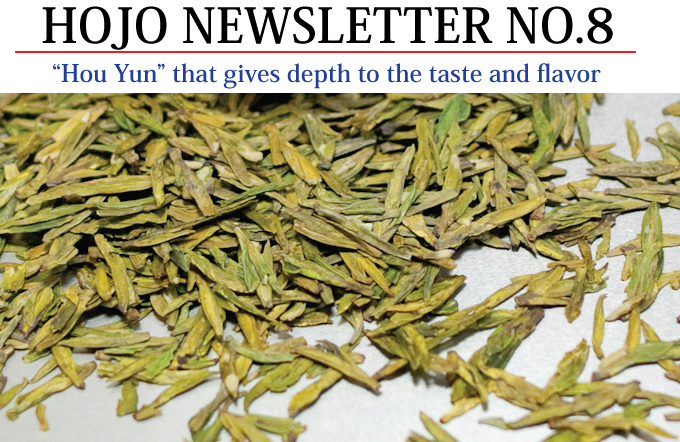
Greetings!
I am Akira Hojo from HOJO TEA SHOP. You are receiving this email because you have registered on our email list when you visited my shop at The Gardens Mall in Mid Valley City, Kuala Lumpur or you have registered on our mailing list on the website.
The other day, I went to the mountain in my hometown for a short walk. When I climbed up the slope, suddenly I saw a bear just in front of me at the distance that was less than 5 meters! It was extremely critical. Usually bear is timid and run away before we even notice. However bear usually attacks human if we suddenly run into bear. Fortunately bear was not aware of my presence at that time. Without second thought I immediately jumped down the slope and desperately ran away. For now, I appreciate for the fact that I can safely write this newsletter.
Anyway, that is all about my bear story. This time, I would like to share my understanding about the criteria to judge the quality of tea.
Go to HOJO Websie Main Page >>
Quality of tea is defined by the depth of taste and flavor. In Chinese it is called Hou Yun. “Hou” means throat and “Yun” means” lasting lingering charm. Hou Yun means the taste that is felt on our throat and lingers. In English, I cannot find an appropriate term to describe this feeling. Perhaps the closest term to describe this feeling is “aftertaste”, “depth of taste” or “long finishing”.
Hou Yun gives depth to the taste. In other word, it builds up the taste in three dimensional way. On the other hand, flavor defines the character of tea. Since I Iike photography, I will use the photography term as an example to explain the difference between flavor and Hou Yun. Flavor is like the color of a photograph. Different brands of camera or lens gives different color. However color does not define the quality of lens or camera. We usually appreciate depth and blur effect that creates a three dimensional visual impact to the photograph. Similarly, Hou Yun means the depth of taste and continuous lingering feeling on our throat. This is what defines the true quality of tea.
Successful candidates can look forward to a highly competitive remuneration package with attractive scheme. On-job training and site training at oversea tea gardens will be provided for the stable staff.
Starting salary range RM1,500 to RM2,500
Work location: Kuala Lumpur, Mid Valley, The Gardens Mall
Responsibility: Daily sales and operation of shop
Working Experience: Not required in particular. Fresh graduate are encouraged to apply.
Malaysia residence
Language: Able to write and speak both in English and Chinese
Age: 22 years old and above.
If you are interested, please send a resume to us at following email address:
![]()
When we look for quality tea, we go in search of tea with intense Hou Yun. Usually the price for tea is in proportion to the intensity of Hou Yun too. If we meet any tea manufacturer who set price not based on the Hou Yun, we are lucky in a way since we can get good tea for cheaper price. Unfortunately, such manufacturer is not able to maintain the consistency of quality.
In selecting tea, the first thing we seek for is Hou Yun. Only with an ideal extent of Hou Yun, then we look into the flavor. No matter how impressive the flavor is, tea with less Hon Yun will not taste nice.
In fact, Hou Yun is not only exists in tea, but in every kind of food. We unconsciously feel a particular food or drink taste nice when it has good Hou Yun.
For example, let’s compare between apple juices which is nice and not so nice.
Is nice apple juice taste sweeter?
In fact, the sweetness between nice apple juice and poor apple juice is almost the same. Even if we add extra sugar, it does not make poor apple juice taste better. Nice apple juice gives a long finishing in our throat. As it is, it gives stronger Hou Yun.
The top quality Long Jing required reservation much ahead before the harvesting is started. Hence I have waited for one year. Finally it is here in our store.
As I explained in the beginning of this newsletter, the quality of tea is defined by Hou Yun. Good Long Jing must give strong Hou Yun as well. However in China, likely to Japan, the earlier the Long Jing appears in the market, the better the selling price. Drinking the earliest harvested tea in spring is customary culture which people are fond of. The earliest available cultivar is called Long Jing No.43. The sprouting season of Cultivar No. 43 shifted 7-10 days earlier than other Long Jing cultivars. Therefore, this cultivar is highly appreciated by farmers as they can make a lot more income selling the early spring crops to the market. Eventually, many farmers removed traditional cultivar and replanted Long Jing No.43.
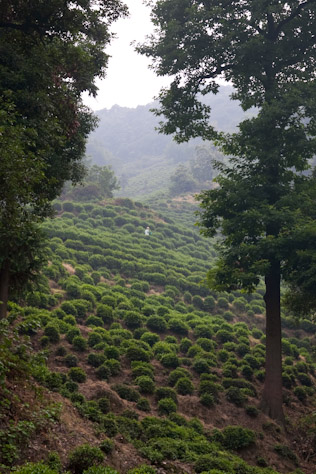 |
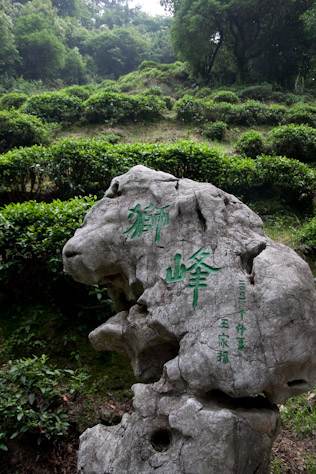 |
|
The mixed cultivar is planted on the steep slope. |
|
Unfortunately early plucking means tea grows faster. Just like the vegetable that is cultivated to grow faster inside green house, the taste becomes thinner and flat. The quality tea must grow slowly to accumulate sufficient minerals and substances so that flavor and taste becomes very rich.
The best Long Jing cultivar in terms of strong Hou Yun is called mixed cultivar. In the course of history, the farmers carried out crossbreeding and produced a better type of cultivar. Long time ago, this mixed cultivar tea trees were planted on Shi Feng Mountain by the ancestors. By nature, this mixed cultivar has much longer root penetrating the ground than other cultivar. Moreover it is very old tea tree. This mixed cultivar is able to absorb sufficient minerals from the soil. As a result, it gives very good Hou Yun. This is the tea I particularly search for. In fact, the majority of Long Jing produced in Shi Feng Mountain is made of other cultivars. Nowadays, those special mixed cultivar is very limited. We selected the earliest plucked mixed cultivar from the higher elevation on Shi Feng Mountain. The leaf size is very small, and consistent in color and size. If you are not satisfied with this quality, that might be beyond the quality of Long Jing.
Go to the Shi Feng Long Jing Page >>
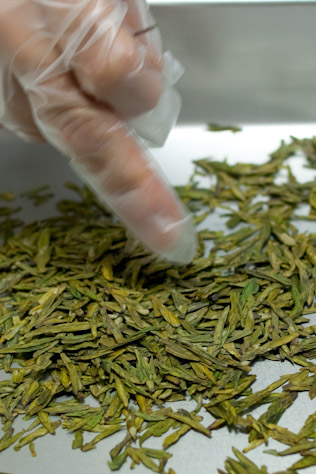 |
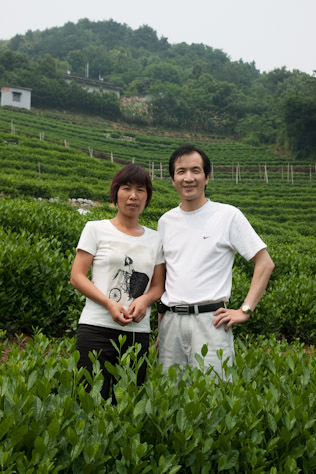 |
|
Shi Feng Long Jing: the leaf size is small, consistent, and yellowish green. |
Mr. Kim and his wife. They are the one who produce Shi Feng Long Jing for us. |
Shigaraki is the name of a place in Shiga Prefecture in Japan. This place was called “Koga” in history. Most Japanese knows this name, Koga, not because of the clay, but Ninja. Koga was the place where Koga Ninja was brought up. In any case, we need to clarify that Ninja has nothing to do with this clay though.
Shigaraki is one of the 6 oldest potteries in Japan. It becomes famous thanks to the clay that is very rich in minerals. Unfortunately modern Shigaraki artists focus on glazed ware such as flower base or plate and none of them produce non-glazed clay teapot.
We have paid attention on this clay for a long time and hoping if anyone could come up with teapot. Finally, we managed to introduce Shigaraki clay teapot thanks to Mr. Masaki Tachi who is usually specialized in Banko purple clay teapot. Banko purple clay comes from Iga area. Ironically Iga also used to be the hometown of Ninja. In the history, Iga Ninja worked for government, while Koga Ninja worked for opposition. Both locations are quite close by.
The teapot is very rich in iron and other minerals. It is baked in reduction fire and appears in beige-orange color. Due to the highly intense porosity, you can even detect the aroma of tea coming out from the clay teapot when brewing tea. When placing teapot on table for a short while, after remove it you can immediately observe the steam remains on the table that penetrate through the clay. We carried out tasting using water in Japan, Malaysia and China and found out that it makes the intensity of Hou Yun extremely strong. Shigaraki clay teapot is suitable for most kind of tea including Japanese green tea, oolong and puerh.
This series of clay teapot is very limited and we are not certain if we are able to continue the supply in future.The availability is subject to the availability of clay and also the willingness of Mr. Masaki Tachi.
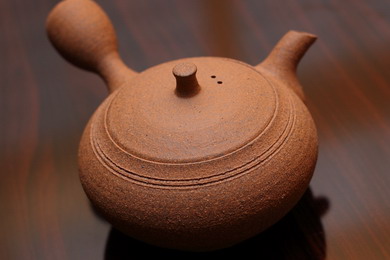 |
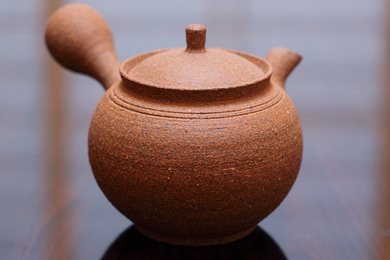 |